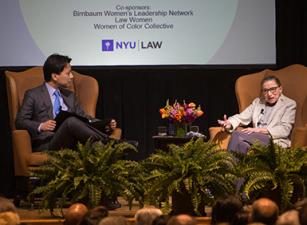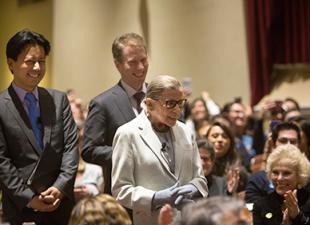Seated onstage in a packed Tishman Auditorium on February 5, US Supreme Court Justice Ruth Bader Ginsburg reached for her handbag and pulled out a small booklet. “My pocket Constitution, which I carry with me wherever I go in the world,” she explained, to the delight of the crowd.
Ginsburg was responding to a question from Kenji Yoshino, Chief Justice Earl Warren Professor of Constitutional Law, in a conversation presented by NYU Law’s Center for Diversity, Inclusion, and Belonging (CDIB). He had just asked her what purpose a constitutional amendment guaranteeing equal rights for women would serve that wasn’t already accomplished by existing anti-discrimination jurisprudence.
Ginsburg answered that if she were to show her copy of the US Constitution—which outlines fundamental tenets of American government—to her granddaughters, one important element would be missing. “There’s no statement in the Constitution that men and women are people of equal citizenship stature,” she said. “Every constitution in the world written since the year 1950 has an equal rights amendment… So I would like to see in this, our constitution, that simple statement.”
Besides the possibility of an equal rights amendment, Ginsburg’s conversation with Yoshino covered a wide range of topics, including her thoughts on the #MeToo movement (“My concern at first was that this shouldn’t just be about the people in the headlines and Hollywood stars—but it’s getting through.”), her friendship with the late Justice Antonin Scalia (“I disagreed with a lot of what he was saying, but I was captivated by the way he said it.”), and the history and future of women on the Supreme Court (Ginsburg reiterated her opinion that she will only be satisfied with the number of women on the Court when there are nine).
Ginsburg noted that she has seen enormous changes for women in the legal profession over her career. At the time she began teaching law in 1963, she was one of fewer than 20 women in tenure-track law faculty positions across the nation. And when she first applied to legal jobs, Ginsburg said, “I don’t know how many times I was told by a law firm, ‘We had a woman once and she was dreadful.’ Now there are no entirely closed doors.”
Discussing her career prior to the Supreme Court, Ginsburg rejected President Bill Clinton’s description of her as the Thurgood Marshall of the women’s rights movement. “My life was never in danger—his was,” she said of Marshall. “When he went to a Southern town in the morning, he couldn’t be sure he’d be alive at the end of the day. I never had that threat.”
She said, though, that Marshall was “a model for me, in many respects,” and she noted that Marshall did not bring Brown v. Board of Education to court until he had won decisions in lower courts that put the “building blocks” for that landmark Supreme Court decision into place.
“That was what was missing when Roe got to the Court,” Ginsburg said, referring to the 1973 Supreme Court decision that legalized abortion. “The challenge was to the most extreme law in the nation, [which declared] the only basis for an abortion was the woman’s life,” Ginsburg said. Although the Court’s decision in Roe v. Wade affirmed a woman’s right to abortion, subsequent decisions have primarily resulted limited rather than expanded that right. “Perhaps, if the Court had proceeded the way Marshall did, with building blocks, we might not have had the result that we had,” she said.
Asked about her experience as only the second justice on the Supreme Court, Ginsburg said that in the years when she and Justice Sandra Day O’Connor were the only two women on the Court, lawyers would occasionally mistake them for one another. She also recalled seeing the headline, “Rude Ruth Interrupts Sandra,” after she had cut off O’Connor in the Court. She apologized to O’Connor afterward, Ginsburg recounted, but the other justice replied, “’Don’t give it another thought, Ruth, the guys do it all the time.’”
These days, Ginsburg said, she and the other women on the Court continue to be unapologetically vocal during oral arguments: “Anyone who observes Court proceedings will confirm that my female colleagues are not shrinking violets.”
Watch the full video of the event (47 min):
Posted February 20, 2018

